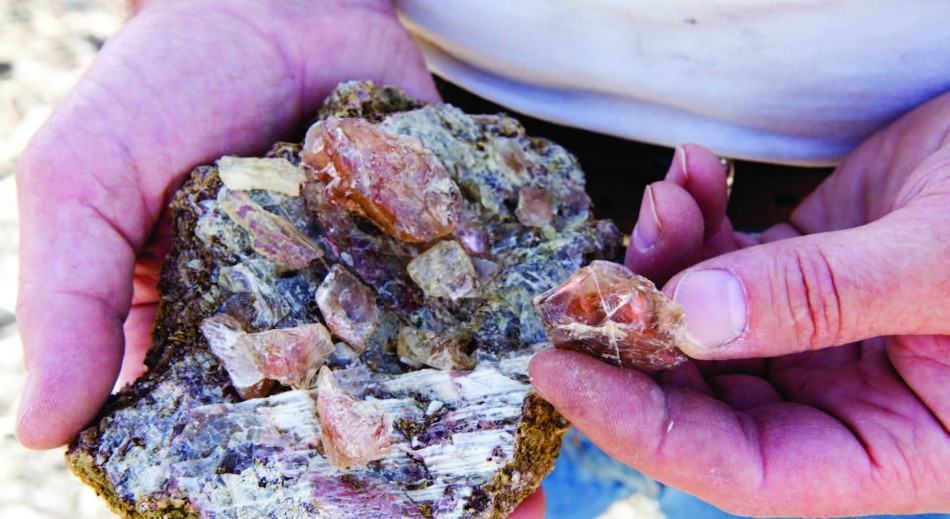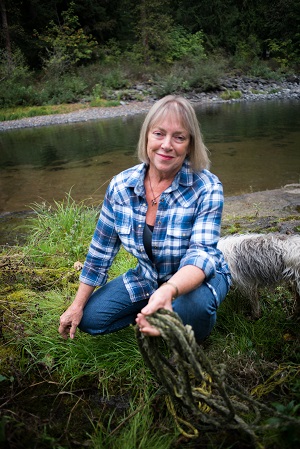Life of an Oregon Sunstone Miner
written by | Alexandra Arch
This post was originally published January 1, 2011
Outside of the tiny southeastern Oregon town of Plush, sunstone mining camps are a post-apocalyptic setting in the vast empty desert of Rabbit Basin. Here, rusty RVs huddle with mechanical shovels whose elbows bend high into the desert sky. Buckets of backhoes tuck their knuckles into the dirt and create piles that will, one day, back-fill the holes. Over an ancient lake bed, the wind exercises gale-force gusto on this high plateau.
“You should see it when it’s windy!” jokes Don Buford, 63, his rotund form clad with dirt-streaked clothing and his long white beard sailing sideways as he climbs down from a backhoe. The rigorous outdoor work over the past twenty years has weathered his face and cracked his hands. The sun has bleached his shirt and the earth has faded his jeans.
Buford’s digging machine comes to a rest among other pieces in the colony within the Dust Devil Mine compound. To a casual observer, though there would be no accidental tourists this far out of nowhere, the Dust Devil compound would appear the last standing vestige of a civilization that has long since succumbed to wind and sand. The closest services are forty-five minutes west in tiny Lakeview.
“We are electricians, welders, mechanics and engineers,” offers Terry Clark, 62, a thin man with deep lines etched in his face, who co-owns and operates Dust Devil. “Out here, we have to be jacks of all trades.”
However different physically Buford and Clark may be, their lives are closely linked. Both were irrevocably changed by combat in Vietnam, have their favorite rocks stashed in their pockets and can’t help but tell stories late into the night. And they love digging sunstone in the high desert.
Buford and Clark first visited the area in 1991 to collect rocks for a teen-age kids’ group. They were taken by the beauty and opportunity. A year later, they scooped up abandoned mineral claims and eventually set up a mining business with hand tools and long weekends. Becoming more serious about their mining, they renovated an old school bus and installed a belt over which they could wash and sort the rock material. These days, the operation comprises 340 acres and employs an optical sorter to increase production.
The greatest pleasure for Buford and Clark and the handful of other miners living and working out in these nowhere camps in southeastern Oregon high desert, though, is finding a perfectly ribboned piece of Oregon sunstone. “Every day is like Christmas out here,” booms Clark. “When you uncover the stones, you are the first ever to see them … stones which are unlike any other.”
There are two main regions where Oregon sunstone is mined. One is about twenty-five miles outside of Plush in Lake County, an area that includes numerous dig-for-fee opportunities at private mines as well as a public collection area that requires no permit. There is also a private commercial mine located in northwest Harney County called Ponderosa that actively distributes Oregon sunstones both nationally and internationally as well as another private mine in the southeastern part of the county that is not a commercial mining operation.
The Dust Devil Mine is the Nexus for Oregon Sunstones
For many rock enthusiasts, the Dust Devil mine has been ground zero for Oregon sunstone, a labradorite sub-group of the abundant feldspar mineral. The semiprecious stone can be found in several parts of the world in yellow and transparent colors. Among the feldspar family, only the Oregon sunstone flaunts an impressive—and coveted—array of colors from champagne to salmon, blue to green to red and sometimes a combination of colors. What further distinguishes it from its international relatives, is the tiny platelets formed inside the stone that creates a dynamic inkwell of color in the stone called “schiller,” which creates an ever-changing incandescent effect in light.
“With the schiller and its many manifestations, you have more variety from one mineral from one mining location than any other gem in the world,” says Steve Douglas, sunstone miner who owns Douglas Fine Jewelers in Bend. “What jewelry designer couldn’t get excited about a palette like that?”
Despite its local consumer appeal, the Oregon sunstone’s place in the larger gem industry is still a mystery. Data concerning the amount and the value of sunstone that is mined every year is elusive. The Bureau of Land Management (BLM) doesn’t keep track of value of sunstone removed from claims or from the public collection area, according to field geologist Steve Flock.
The extracted rough is only a fraction of the stone’s potential value once it is cut and polished. Unlike diamonds, whose retail value can be fairly determined from the rough stone, there is no equivalent measure for sunstone because the color and quality of the gem varies so much, according to Douglas. The top grade rough will sell for $10-$15 per carat, he says. It’s the cutting of the colored material that adds value. Because of the irregular shape of rough sunstone crystals, the average yield after cutting is a low 12 to 15 percent of the rough stone. Douglas circumvents the network of industry intermediates by digging the stone in his own mine, adjacent to that of Dust Devil, and taking the stone from mining, to cutting and polishing to retail sales in his own store.
Long before Buford and Clark’s Dust Devil claim, the Oregon sunstone had a function, value and allure. The ancestors of the Northern Paiute and Modoc tribes were likely among the first people to find and use Oregon sunstone. In addition to using it in barter with other tribes, Native Americans used the stone for burial rituals. There is also anecdotal evidence they used it in ceremonies to invoke the healing power of the sun.
In the late nineteenth century, ranchers came into Rabbit Basin and cowboys picked up the sunstone, trading it to local stores and beyond. Eventually, the stones passed under the noses of Tiffany & Co. in New York City. The world renown diamond jeweler bought claims in the area and coined the term “Plush Diamond” in hopes of marketing the clear stones. Due to logistical and marketing difficulties, Tiffany sold all its claims in the 1910s and cleared out, according to some. Buford insists that Tiffany & Co. still held claims into the early 1950s.
Today the BLM owns most of the thirty square miles that comprise the sunstone area near Plush. In Lake County, there are approximately 370 claims ranging from twenty to 160 acres that surround a 2,500-acre public collection area. According to BLM data, there were more than 10,000 visitors to the public collections area between 2009 and 2010, or double the number of people who visited in 2000.
Oregon Sunstones: Mutiny for the Bounty
Naturally, where there are expensive gems, there is risk and danger. Where there is danger, there are guns.
A .22 caliber gun hangs in a Western holster on John Aldrich’s hip. A 56-year-old man with sky blue eyes and a long brown ponytail, he appears more like a modern-day gunslinger. His wife, Debbie, carries a smaller more practical .38 Special for what she calls “inventory control.” Beyond the artillery, the Aldriches are inviting people who operate Double Eagle Mining Company, a fee-digging site along a string of mining encampments not far from Dust Devil.
“I’ve never been one for the city,” says Aldrich as he pulls a smoke from his Dickies denim overalls and lights it under the brim of his sweat-stained hat. His blue eyes flick towards the incoming storm. The business started slowly, he explains. Many years ago after back surgery, he began faceting—cutting stones to pass the time. Hooked, Aldrich bought an abandoned claim six years ago and moved to the high desert with his wife and their two Malamutes. After five months of finding few sunstones with color, Aldrich went down to the pits after his morning coffee, began working and immediately struck proverbial and literal pay dirt.
Grinning like a kid, Aldrich produced a single 298-carat sunstone he calls, “The Dragon.” The stone has a blue vein pulsing through it, and the schiller changes colors in every angle of the afternoon light. With a price tag of about $5,000, it has sentimental value to Aldrich, but the right price would make it less sentimental.
The Dragon was a good omen for the ensuing dig. “It was the tip of the iceberg,” he says. “I still get excited to see the stone in the pits.”
Double Eagle’s business primarily attracts teenage boys and their families—the future geologists and gemologists of the world, Aldrich mused. “It’s the same reason that I originally came here,” he says. “People come here and dig up the sunstone, and each piece has a story behind it, and it becomes an heirloom passed on with the story.”
And stories certainly abound among the mining camps, especially some of the more sordid nature whispered later in the evening. Some touch on animosity between the mining camps, such as that of Dust Devil and Spectrum where charges of fraud, non-compliance, claim jumping, being wanted by the law, or worse, fly.
“This is a trade ripe for armed robbery, but the people out here are probably not the ones you should be messing with,” cautions Buford.
Both Dust Devil and Spectrum claim to be the largest sunstone producers in the area with the best quality of colored stones and offer a litany of complaints about each others’ business practices or dwindling supply of ore.
“This is the fringes of society in every way,” says Chris Rose, owner of Spectrum mine. “It is a Wild West mentality. But it is beautiful nature … the sunset, the rainbows. We are ultimately here because of the rocks.”
A tall, muscular man with a tan face and a soft voice, Rose, 44, has owned several large claims in the area for the last thirteen years and considers his property to be the original Tiffany & Co. mine from 1913. Buford disputes this, citing another location nearer to his Dust Devil claim to be the original pit. Rose is a long-time rockhound who touts the buying power of sunstone and its “en vogue” status in the international gem trade, especially in China, Japan and Germany. He sells it by mail and at gem shows, the biggest of which is in Tucson, Arizona.
“Most of the people who buy from me are small high-end gem and jewelry businesses offering unique, rare and high-end gemstones,” he says. “It is a niche market that is best supplied by smaller companies.”
In late 2006, the show “Cash and Treasures” on the Travel Channel featured Spectrum Mine in a segment in which the host of the show found a 30-carat red sunstone. Thousands of viewers streamed to the mining area to try their luck. Enabling people to find the rock themselves is a valuable experience, Rose contends. “You can’t manufacture places to do this in the world,” he says. “You can’t make a mine in China. It’s not Disneyland.”
The story of Oregon sunstone begins in the stark country of the Oregon Outback, an untamed area with trailers, shovels, backhoes and guns. It ends in places with soft couches, woven rugs, spot lighting and alluring jewelry cases filled with polished Oregon sunstone, its schiller beaming.
Underneath lamps in the back of his jewelry store in Bend, Steve Douglas takes rough stones he mines from his claim outside of Plush through a process of polishing, carving and setting. No matter how polished, carved and set the pieces of semi-precious Oregon sunstone are, they inevitably tell a tale of their rural origin. Perhaps it is the larger story of the Oregon sunstone—its history, its remote location, and its gun-toting diggers that gives the Oregon sunstone its luster.
“It’s still a blast for the casual miner to go out and mine their own $1,800 gem,” Douglas says. “We’ve made custom jewelry for a number of world-class gems found by people that dig for the sheer fun of it.”
What is a Sunstone?
Feldspar is the single most abundant mineral group on Earth and accounts for one half of the Earth’s crust, according to the Mineral Information Institute. Feldspar forms in a variety of thermal environments, during the crystallization of liquid rock (magma), by metamorphism of rocks deep in the earth and in sedimentary processes. The United States is one of many countries that mines an abundant supply of feldspar that is used to make dinnerware and bathroom and building tiles.
Oregon sunstone is a type of labradorite, a sub-group of plagioclase feldspar. The rock in which the sunstone is found outside of Plush is thought to be part of the Steens Mountain Formation, an eruption that occurred about 16 million years ago that pushed the feldspar crystals onto the surface via the molten lava, according to Jason McClaughry, a field geologist for the Oregon Department of Geology and Mineral Industries.
Scientists are still not sure if the sunstone-bearing flows in Harney and Lake counties are related. In fact, there isn’t much scientific research conducted on Oregon sunstone as there are only theories on how the gems were formed and what creates the “schiller” inside the stone, traditionally thought to be copper inclusions.
The lack of scientific data has inspired the research of University of Oregon student Don Stirewalt studying the state gem. Stirewalt believes that the gems don’t contain copper platelets in them and is working with the latest technology to find out the origin of this anomalous gem that is unlike any other sunstone in the world.
Sunstone Setting and The Andesine Sabotage
If Dust Devil is largely responsible for the rise in popularity of sunstone, andesine is the gem that nearly killed it. Several years ago, gemologist Martin Guptill recalls first seeing at a show this “new” colored gem, reminiscent of Oregon sunstone’s coloring. “The material looked fishy to me,” he says. “It was too uniform. The coloring was the same in every piece, no rough stones were ever available to see, no pictures of the mine where it originated, and no clear indication of where it was from nor a particular company that was associated with it. It’s like the old cliché, ‘If it seems too good to be true, it probably is,’” he says. “That’s when I tried to make some noise.”
Guptill and others speculated that the rock was being heat-treated in order to acquire the Oregon sunstone coloring and schiller. Retailers, both big and small, snapped up the stone including television shopping networks such as Jewelry TV. Guptill was one of a few people in the industry to contact Robert James, the founder of the International School of Gemology in Texas, to investigate the stone.
Guptill prepared some of the rock samples for James’ lab to analyze. When the results pointed to fraud, James formally blew the whistle. A class action suit against JTV soon followed. The plaintiffs alleged that the retailer knowingly sold stones that were heat-treated and marketed as a “highly coveted, extremely rare, all-natural, expensive gem that looks like an Oregon sunstone.”
The lawsuit was settled in the fall of 2008 with JTV never admitting wrongdoing. It was the credibility of independent jewelers that really got burned, Guptill noted. “Many of them won’t buy sunstone now,” he says. “Just when Oregon sunstone was starting to get some attention, here comes andesine to spoil the party.”
According to Dust Devil Mine’s Don Buford, the andesine scam cost the industry several million dollars in sales and for some, cast a long shadow over the future of the stone. With some of their bona fide Oregon sunstones replacing notorious andesine on JTV, Buford and his partner, Terry Clark, still look to time to heal the wounds of credibility.
High-end gem cutter Dalan Hargrave gravitated towards working with Oregon sunstone because the stone was easy to “work up,” and not too soft for jewelry, but mainly because he was drawn to the schiller.
“The stone is doing something more than what the cutter is doing — it is a nice play of light,” Hargrave says. Transitioning from a career in goldsmithing to stone carving, Hargrave has won at least ten awards in international competitions using choice pieces from the Dust Devil mine.
The marketing push from miners behind Double Eagle, Spectrum and Dust Devil, enthusiastic rock hounds and independent jewelers have put the Oregon sunstone on the map, according to Martin Guptill, a graduate gemologist from the Gemological Institute of America. “The people who like sunstone are people who are looking for something different,” notes Guptill. “They don’t walk into an ice cream parlor and order vanilla.” Instead, they are looking for the one-of-a-kind pieces.
As with many in his field, Guptill started cutting gemstones as a hobby and developed it into a profession. He knew nothing of the Oregon sunstone until he met Dust Devil’s Buford and Clark at a gem show. It was love at first sight, and it quickly became his favorite stone to work with.
Economics of Oregon Sunstones
Unlike other stones that are heavily marketed from the top down, sunstone’s demand comes from the ground up. “It’s a grassroots consumer interest that has sprouted faster than the trade’s interest,” he says. “A lot of jewelers consider it the red-headed stepchild of gems.”
Because of its rarity and limited supply, Oregon sunstone should bring a higher price. But because of its obscurity, its value is diminished, according to Guptill. In an informal survey of Pacific Northwest jewelers, only one store had a sunstone ring in stock and many had never heard of the gem. Jeweler Karla Proud of Exotic Gemstones in Bend, however, cites notable successes for the stone: a few of the western Ben Bridge Jeweler stores, a chain of seventy stores throughout the U.S., regularly carries the stone, and Tiffany & Co. has a long-standing order with her for extremely red sunstone beads—an order that she has been unable to fill yet.
On the whole, larger gem houses, both domestic and foreign, recognize that there is a limited and quite localized production of the stone that would not meet their demand, Guptill explains. But, for what attention the stone does receive, the Dust Devil duo are its unlikely chief marketing officers.
Every year, Dust Devil exhibits in the fifty-seven-year-old Tucson Gem and Mineral show and has invited gem-carvers to come to the mine and participate in “dig ins,” events in which the artists are allowed to keep a portion of what they find for free provided they carve the piece and enter it in competition.
Back on Oregon’s southeastern high desert, where the wind carves a rugged path, Buford and Clark dream of seeing Oregon sunstone adorn the necks of Hollywood’s biggest stars and of retiring after twenty years in the dirt. They’ve put Dust Devil mine up for sale and hope to rejoin their wives, as Clark will pursue his hobby of blacksmithing and knife-making while Buford splits his time hitting the road in his RV or sailing. Both hope to stay involved in rockhounding and mining, but on a much smaller scale.
“The rockhounds, the stone cutters and the jewelry designers are some of the best people in the world,” Buford says. “We have friends all over the world who we would not know if it weren’t for being in the mining business. We will miss the excitement of people finding treasure in our pit and finding stones that are different than any we have seen before.”










This is a great article! I am in search of that perfect little sunstone. Not greedy, don’t need a million of them, just that one perfect little one that speaks to me;) What would my chances be of finding one if I were to head out there late spring? What would I need to do. (novice..) Thank you so much!
I’m dismayed by the one negative comment.
We were quoted but ended up paying nothing considering the value of stones we came away with!
Don and the crew were amazing, informative and fun! Our niece and nephew were visiting from Las Vegas and thought it was the coolest thing ever…LOL…and that is saying something!
I ended up with beautiful jewelry and a carved piece that will be a family heirloom forever. Plus rough stones still to be cut to boot. Don gave the kids a handful just to take home.
Let alone the story of the day to be retold forever. They were so gracious.
So thank you Dust Devil Mining. We only hope we can do it again some day!
Terry and Don are two of the greatest men i have ever known. I have known both of them for almost 30 years and am so happy that they have been able to follow this dream.
Is there anywhere on the northern Oregon coast to purchase one? Ill be there next month.
There’s a new shop in Lincoln City called Prehistoric. They have all sorts of gems and stones. Super cool store!
Depot Bay, the Blue Heron. The fellow who owns that shop owns the biggest Sunstone mine in Oregon. He doesn’t do fee digging at his mine but has some beautiful stones in his store. Also look on ebay!
Spectrum mine is the only place to dig in my opinion.. Dust devil is out of stones and charged wayyyy to much.
I love it a the Plush Diamond (Sunstone) Collecting area. I have been there numerous times over the last 20 plus years. I am now 70. My wife and I found out about the area from a magazine area about a man that had a shop in Plush. I think he later had some of his stuff in the Plush Store. My brother and I are planning a trip next month, October, to the Sunstone Area. We have been there in October so we know the extremes in weather. By the way, Don Buford Helped us the time when my brother and I were last there. We broke down by their Mine the Dust Devil, when we were leaving the area. I believe the battery went dead. What ever, we made it home. Thanks again to the Dust Devil Mine.
you are a great man. I love oregon sunstone and hope you can cut a rough I buy off EBAY for me please, it is a dream of mine
I now own a gorgeous finished Oregon Copper Bearing Sunstone, that exhibits lots of red and brownish orange flashes. It's one of the most beautiful stones, with play of color that equals that of Alexandrite. The sunstone is gaining popularity quickly now and prices are starting to rise. If you have the opportunity to purchase one of these magnificent stones, don't let the chance slip by. You won't be sorry. My stone comes from the Rabbit Basin area, where some of the colorful rough, has been found to date.
One only needs to drive to the mine and seek these two and you will see why Dust Devil is such a great place to mine. Ten years ago I could not imagined I would still be returning to this mining adventure spot,but here I am. Oregon Sunstone a truly unique gemstone. There truly is nothing like it,search as you will nothing!